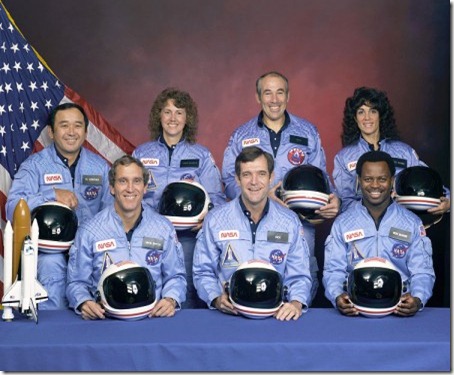The Day that Star Trek Died
Twenty five years ago, the Space Shuttle Challenger exploded shortly after lift off, killing seven astronauts. But for me, that explosion over Cape Canaveral took away Captain Kirk, Spock, Bones, and all the other denizens of the United Federation of Planets.
I grew up with Star Trek. My parents divorced when I was 9, so I don’t have a long memory of happy times in my house, but of the times we did have, Star Trek held a kind of magical memory. It was one hour, each week, when we all sat quietly and watched our “big” 20-inch black and white television. It was one hour when we could see a vision of the future, where people weren’t rioting about the color of their skin or their country of origin, where money wasn’t the only motivation for smart people to succeed, and where intelligent, passionate people followed higher ideals than self interest. I wasn’t the only one watching.
Dr. Ronald E. McNair was also watching. He, too, had grown up watching Star Trek, and imagining what it would be like to be an astronaut. One big difference: Dr. McNair was black, and he grew up in the segregated city of Lake City, South Carolina. On Star Trek, he saw white people and black people working side by side. As his brother Carl told Storycorps years later, Star Trek’s hopeful vision was one of the inspirations that led him into science (where he became and expert in quantum electronics and lasers) and then into space as a mission specialist. He was the second black man in space in 1984, when he flew aboard a previous Challenger mission.
In 1986, I was a young software developer. I’d been working with computers for many years by then, including such golden oldies as the IBM 370, the DecSystem 10, and the HP/3000. These were also the early days of the microcomputer. I had the opportunity to spend some time, (but very little professionally), on the Kaypro, the Compaq Portable, and of course, the IBM PC. I was employed at a small manufacturing company in Tennessee called DeRoyal Industries. They made a variety of different medical products, from orthopedic braces to surgery trays. They also had a small software division, where I worked to create a product for hospital operating rooms to allow them to schedule surgery efficiently. It was all on Unix System V, running on an AT&T 3B2/400 minicomputer. In those days, the word “hacker” was a compliment, Zork was cool, and we were thrilled to use the UUNET to make computers talk to one another.
But America was no longer investing in Space. In constant dollars, the budget of NASA in 1986 was one third that of 1966. America was losing interest. The drama was gone. In 1984, President Reagan placed a challenge at NASA’s doorstep: build a permanently manned space station, but he didn’t increase NASA’s budget to make it happen. So, when NASA went on a nationwide search for a teacher to travel into space, they wanted to add some interest, especially from children. The idea was to capture the imagination of the next generation of astronauts, just as Apollo had captured me.
So, on the morning of January 28, 1986, millions of schoolchildren were tuned in, and television stations around the country were all showing the launch live. After all, a teacher was onboard. She was one of us. We all sat in awe as the countdown reached zero, and the rockets fired, and the shuttle gracefully headed toward space. And 71 seconds later, we all watched in horror as the solid rocket booster exploded, destroying the Challenger and her seven-man crew: Francis R. (Dick) Scobee, Michael J. Smith, Dr. Judith A. Resnik, Dr. Ronald E. McNair, Ellison S. Onizuka, Gregory B. Jarvis, and Sharon Christa McAuliffe, the first teacher in space.
I was heartbroken. It was the first time we’d lost a mission. It was the end, for me, of the dream of space that had started with Star Trek. After that awful morning, no one spoke of NASA with the hushed tones of awe that I remembered from my youth. Now, it was only talk of price tags, and O-Rings, and the failure of NASA to deliver on Reagan’s (unfunded) challenge. NASA was no longer a place I wanted to work. Visit, yes. Support, sure. They were the only game in town. But to work there, or become an astronaut… that dream died in 1986. For me, that was the day that Star Trek died.
